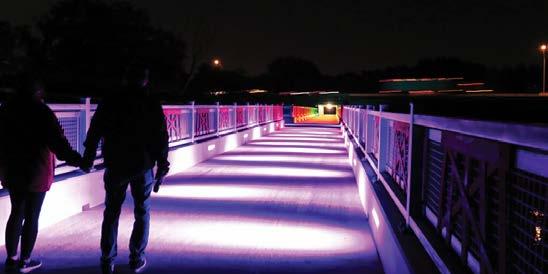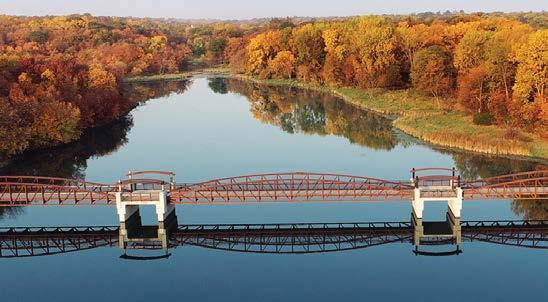
4 minute read
Unique Trail Bridges Create Tourism Draw
SNYDER & ASSOCIATES

Advertisement
The rapid and continual expansion of multi-use trails across the United States has opened a new world of recreation and exercise options. Along with the trails, pedestrian bridges have experienced a comparable increase in the construction of unique, iconic, and picturesque structures to complete trail connections. Spanning rivers, lakes, roadways, and valleys, these bridges are no longer simply utilitarian pieces of infrastructure that connect point A to point B. Instead, the bridge often becomes its own destination.
Many of these bridges have been designed by engineers to be both functional and visually appealing, with features such as arches, curves, and different colors and textures. Some bridges are also built with artistic elements such as sculptures, ornaments, and lighting, adding to the overall aesthetic appeal. The Trestle-to-Trestle Bridge in Johnston, IA is a prime example. This bridge has quickly become a major draw, not only for nearby residents in search of recreational opportunities but also for tourists who are drawn to the intricate light displays that illuminate the structure at night.
Railroad bridges along abandoned stretches of track have also become incredibly popular as the Rail-Trail concept has taken off. Giving these structures a second life as a trail bridge can greatly reduce expenses for the owner community when compared to building a new structure. The High Trestle Trail Bridge between Woodward and Madrid, IA highlights the impact of reusing a railroad bridge on a massive scale. This 2,530-foot-long, 130-foot-tall bridge over the Des Moines River was constructed on nearly two dozen existing concrete piers from a former railroad bridge. This structure not only draws recreational trail users but also has become a magnet for railroad and train buffs who enjoy viewing the repurposed structure.
Some trail bridges draw visitors because they’re visually attractive, and they provide access to equally stunning scenery. The Mark C. Ackelson Trail Bridge in Easter Lake Park checks both of those boxes. It seemed unlikely at fi rst, but this pedestrian bridge has become a tourist attraction in its own right. People visiting the park make it a point to stroll across the bridge and catch the one-of-a-kind views over the restored wetlands. The entire span is well-lit and features several viewing outcrops along the way for people who need to rest periodically on the journey, take in the breathtaking landscape, or simply want to sit and watch other pedestrians go by.
Reprinted from Snyder & Associates Newsletter
IMPROVED ACCESS, ECONOMIC BOOST & INCREASED RECREATION
In providing connections across once-impassable spaces, bridges and trestles can address environmental and equitable access concerns in areas where people otherwise would need motorized transportation. At the same time, they can be critical in linking together larger networks of trails, which serve as major tourism draws and economic engines.
The construction of trail bridges creates jobs for the local community and increases economic activity by boosting local businesses. And as part of hiking and biking trails, they can provide access to parks, nature preserves, and other recreational areas. When strategically positioned, they’re often used as backdrops or gathering places for community events and festivals, providing a unique and memorable experience for participants. ■
Recent Trail Bridge Projects
Trestle-to-Trestle Bridge
Beaver Creek, Johnston, IA
In the spring of 2019, the Trestle-to-Trestle Trail Bridge over Beaver Creek, Johnston, IA, was severely damaged by an ice dam and collapsed. The former trail bridge was originally a 316-foot-long timber and steel railroad bridge that had been repurposed for trail use. When the ice dam caused its collapse, designers knew they needed to create a replacement that could withstand greater threats from fl ooding and debris. The Snyder & Associates team along with structural subsidiary, Shuck-Britson, were able to create a replacement bridge that far surpassed the structural stability of its damaged predecessor.
The fi nal design for the new bridge is a much more solid structure that incorporates modern aesthetics with practical design applications. A customized LED lighting system is incorporated into the design and is unique to a structure of this type. It not only illuminates the bridge deck and approaching trail path but also the underside of the bridge. The lighting system can be programmed to change colors in a near-unlimited pattern, sequence, or timeframe, creating a one-ofkind visual attraction for trail users and vehicle traffi c on nearby Interstate 80.

2,526-foot-long span to accommodate the increased hydraulic pressures created by the Saylorville Dam and Reservoir project just 15 miles downstream. When the railroad went bankrupt a few short years later, the bridge sat largely unused for several decades. When the idea for the trail bridge was introduced, the massive concrete bridge piers had barely been “broken in” and could easily provide the solid footing needed for the trail bridge. The resulting structure is a major draw for not only recreational trail users but also railroad tourists who travel to the site to experience this grand reuse of a rail structure.

High Trestle Trail Bridge Des Moines River, Madrid, IA
The focal point of the High Trestle Trail is the impressively long bridge over the Des Moines River valley between Madrid and Woodward, IA. Constructed on existing concrete piers from a former railroad bridge, the Snyder & Associates team coordinated with public artist David Dahlquist on the design of the bridge.
While the original steel girder railroad bridge was built at the location in 1913, it was replaced by the U.S. Army Corps of Engineers in 1973 with a new

Mark C. Ackelson Trail Bridge
Easter Lake, Des Moines, IA
As part of the Easter Lake, Des Moines, IA, restoration project, a separate but coordinated component of the plan was the creation of a trail project to encompass the lake and connect with other area attractions. Named in honor of the former Iowa Natural Heritage Foundation president Mark C. Ackelson, the trail project was designed by the Snyder & Associates team and included a signature trail bridge.
The stunning Ackelson Trail Bridge is located at the west end of the trail and serves as an impressive focal point with overlooks at each pier. The tranquil environment and magnificent views draw nearby residents, as well as regional visitors to experience this one-of-a-kind trail bridge and surrounding park.
Around the world, bridges have long served as the hallmarks, gateways, and centerpieces of communities, providing connectivity that has a major impact on active transportation, tourism, and economic development. They can be an important part of community development and can even help to revitalize local economies.

Above all, pedestrian trail bridges can be more than just functional structures, they can be destination locations that attract tourists, create jobs, and provide recreational opportunities. ■








